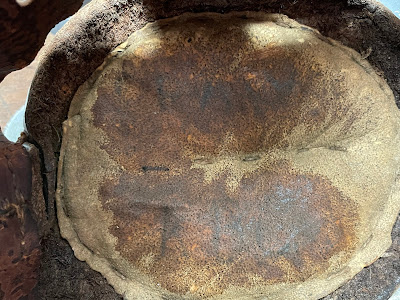The Princeton Head Harness, a helmet type
commonly produced by major sporting goods manufacturers between 1912 and 1929,
is reconsidered with this unique example, which may date back as early as
1897—over a decade earlier than one would previously have assumed. Initially,
our research suggested the helmet was manufactured around 1900. However, after
further handling and extensive investigation, we now believe it could date to
as early as 1897. It is the earliest known example of the 4-attachment
Princeton style helmet and one of the earliest models of any known football
harness.
This helmet challenges the conventional timeline of helmet
evolution. Well-worn and featuring numerous period repairs, it exemplifies
early helmet construction. The use of lightweight, thin, flexible leather,
along with a well-ventilated design—featuring punched holes in the ear pieces
and across the body—demonstrates both functional and innovative craftsmanship.
The padding consists of a hair-stuffed crown and fine fiber or straw-stuffed
ear pieces. Though the manufacturer remains unknown, the very early
construction materials, techniques and craftsmanship is comparable to early
designs like the Spalding No. 15 or 25 from 1894 (designed primarily for the
protection of one or both ears) (1894 appears to be the first year in the
introduction of the head harness, in this case as ear protection) (see note 1
at the end of the post).
Similar to the Spalding No. 15 or 25, this head harness
includes punched ventilation holes in the ear pieces and forehead straps;
although a 3 inch section of leather has been replaced at the forehead—likely
due to damage from years of use. This design may represent an intermediate in
harness evolution, potentially bridging gaps between the Spalding No. 25 and
subsequent models.
It’s also possible that this helmet
corresponds to the Spalding No. 40 Chicago Style Harness, advertised in 1897,
though no illustrations of that model exist.
It is plausible that this helmet was an earlier influence
to H.B. Conibear's 1901 design of the Chicago head harness. Both designs
feature a “floating” crown piece and four points of attachment or strapping, allowing
for maximizing ventilation. Given these shared innovations, it seems unlikely
that these helmets were conceived of independently.
There are a handful of early previously
unknown head harnesses that have come to light, such as this Princeton style
helmet, that are actual physical examples. Other examples from these first
years of head harness development may only appear in period photographs,
advertisements or articles. In these photographs, the harness style is often
difficult to determine. This leaves us with questions relative to their
development, their date of manufacture, and their manufacturer.
In our research,
for those interested in football helmet history, we found reference to another 1894
head harness that may describe the earliest version of a four strap spoke helmet.
Possibly an early example of a Larwood model head harness. In this instance, this
early harness is for both ear and head protection. The 1894 description reads
as follows: “The elaborate headgear is made of light watch spring steel,
leather straps with lamb’s wool facings and vulcanized rubber. A wide band of
leather, with the lamb skin next to the flesh, passes across the forehead to
the rear of the head. A center strap, similarly constructed, passes back over
the head. From the encircling band are wide, padded straps, which encompass the
ears in horseshoe shape and extend well forward to the cheeks. The rubber nose
mask, a stiff affair, extending over the mouth and to the chin, is attached to
the forehead strap and the cheek pieces. The whole harness is held securely in
place by elastic bands under the chin and at the back of the head and neck by
elastic bands and buckles.” (See note 2 at the end of the post).

A circa 1904 cabinet card (above), though we only
retain a screenshot, provides a definitive photo match in at least three areas
with this exact helmet. Additionally, an article published in L’Amérique
Moderne by Jules Huret, combining two earlier works from 1904 and 1905 (see
note 3 at the end of the post), includes a photograph (below) that appears to depict the same model helmet. If taken during Huret’s attendance at the 1901
Harvard-Yale football game, this could be photographic evidence of a player
from either team wearing this specific helmet design. This further supports the
theory of its use around the turn of the century.
Original Caption – “A Football Player – Football as
played in the United States is an extremely brutal game that requires players
to protect their heads, mouths and noses with a helmet made of boiled leather.”
Letters inscribed inside the helmet on
the crown pad, though partially obscured and difficult to discern (much more
visible when wetted), offer further intrigue. Our best interpretation of these
letters suggests acronyms such as KBC/KBO/RBO and PAW/PMW - their significance
remains an interesting part of the puzzle.
As the only known surviving example, this
early "missing link" head harness represents a crucial piece of
football equipment history.
Note 1 – We have over a half dozen advertisements
and articles showing that the Spalding 15 and 25 were being manufactured, sold
and used in play in 1894. Two illustrations, both from October, 1894 are shown.
Note 2 – Illustration from October, 1894 of the
described head harness
Note 3 - L’Amerique
Moderne by Jules Huret , an illustrated edition that combined two earlier
publications by the same author, En Amerique - De New York a la New Orleans,
1904, and En Amerique - De San Fransisco au Canada, 1905.




















































